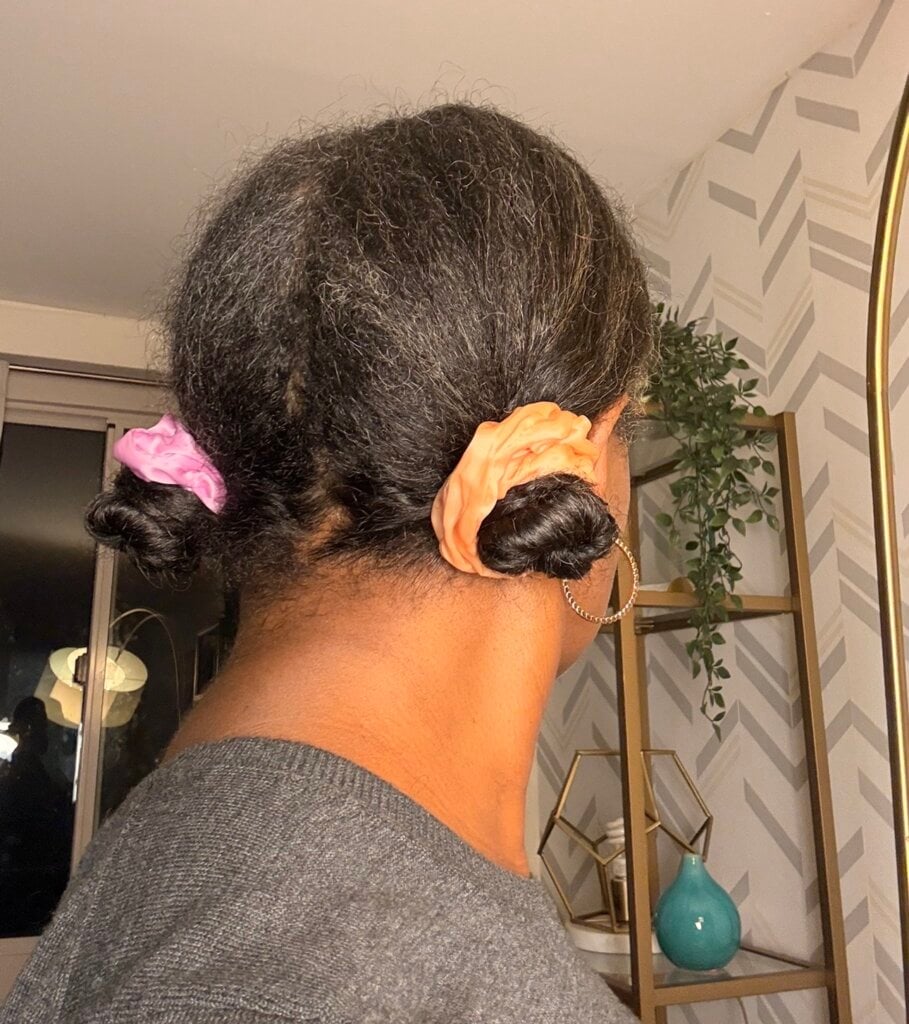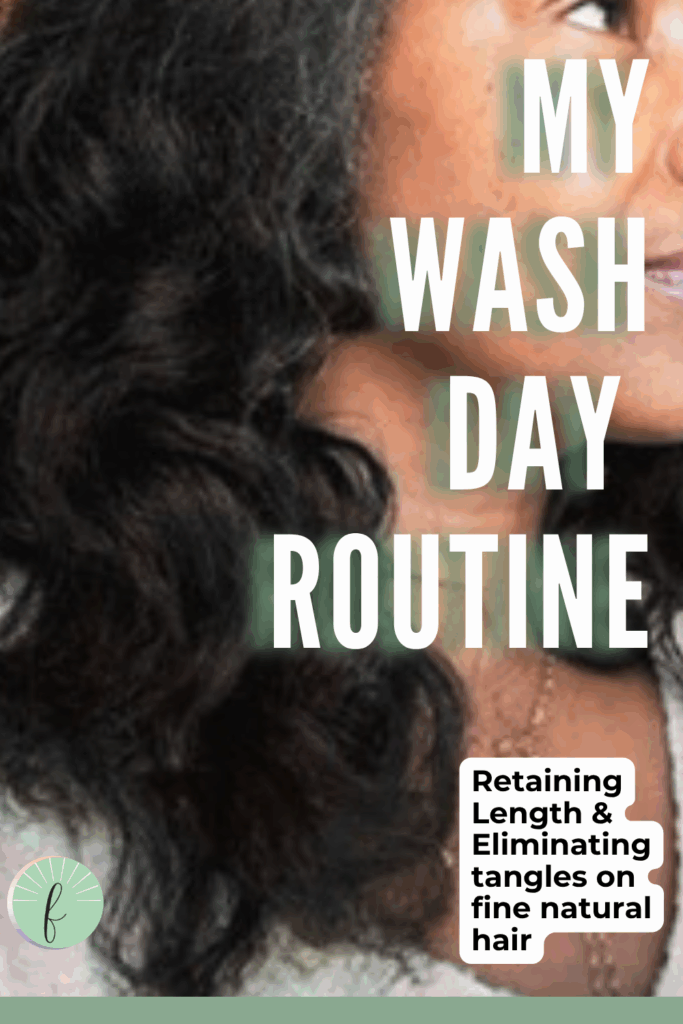It’s been some time since I’ve shared a wash day routine, and boy has it changed. In this post, I’m sharing my new standard for wash day that has helped me retain more length so I can see the hair growth I’ve worked so hard for.
I trust that if you follow how I go about my fine natural hair wash day, you can achieve similar results.
Some time ago I shared tips for how you can retain length on your natural hair doing wash and go’s. I still stand by that for most naturals who have curly hair textures.
However, the issue is that while I believe you can retain length doing wash and go’s, it’s not the best method. Especially, if you want to see your length come in more quickly.
So, without further ado, here’s my standard for wash day that I follow for my fine natural hair. And yes, it does include heat.
Surprising? Keep reading.
Wash Day Summary
I’ll go into detail on each step, but here’s the summary of my 7-step wash day routine:
- Pre-Poo
- The Cleanse
- Detangling
- Deep Conditioning
- Protein Treatments or Henna Glosses
- Blow Drying to Stretch
- Styling (1 of 2 Ways)
Is it a coinky dink (I’m old school) that the number 7 is God’s number of completion?
I don’t believe in too many coincidences. I also didn’t plan to just list 7 steps. This is just what it is, so please don’t make it too deep.
The Pre-Poo

I’ve always pre-washed my fine natural hair, so this hasn’t changed much. Only what I use to do it has changed.
I pre-poo with an oil now. No conditioner. I just slather on a coconut oil-based product. However, you can use whatever oil penetrates your hair best. However, coconut oil is proven to penetrate the hair shaft to protect against hygral fatigue.
Hygral fatigue is damage caused by the expanding and contracting of the hair shaft when washing it. Coconut oil is proven to mitigate that.
The Cleanse
I’m strictly a shampoo kind of girl. I do not cowash. In my personal opinion, it’s similar to washing your body with lotion.
To see predictable hair growth, you need to maintain a clean scalp.
Detangling
After shampooing my hair scalp, I go right in and detangle it in the shower, working in sections. Takes me 20-25 minutes, no matter how tangled my hair has gotten.
Yes, it’s the product I use. More on that shortly.
Deep Conditioning
Some naturals don’t think that deep conditioning is necessary every wash day. I disagree because when you deep condition, you hydrate the inner structure of the hair.
So, I deep condition after every wash.
Protein Treatments or Henna Glosses
The need for protein treatments can definitely depend on your porosity levels. High porosity hair typically needs more frequent treatments. Low porosity hair usually doesn’t need it as often.
The exception is those of us with fine hair. Fine hair doesn’t have the structural integrity that thicker strands have, so protein treatments are beneficial.
My stylist recommends you determine if you need a protein treatment based on how your hair feels:
- Breakage
- Excess elasticity (that mushy, gummy feeling)
While I agree with this, I still like to use a light silk protein treatment even when my hair doesn’t feel like it needs it.
I alternate protein treatments with adding a tablespoon of henna to my deep conditioner.
Lastly, if I’m planning to use direct heat on my hair when styling, I’ll skip the protein treatment and use bond repair/maintenance products. Specifically OLAPLEX.

Blow Drying to Stretch
Next up is blow drying my hair. This is where things have changed. In the past, I would set my hair in a wash and go, or I’d go straight into twisting or braiding.
To reduce and practically eliminate tangles, I have found that keeping my hair stretched is best.
There are many ways to stretch natural hair (click that link for all the ways). Yet, the fastest way that gives the most stretch is the use of heat – specifically with a blow dryer.
Side bar: When you use heat responsibly, the risk of heat damage is very low
Why I Don’t Get Heat Damage Blow Drying

I’ve been blow-drying my fine natural hair after every wash day for about 2 years as of the writing of this post and haven’t gotten heat damage to date. There are reasons for that:
- I use the RevAir reverse air hair dryer (the gentlest dryer ever created) to dry my hair most days. Read up on my step-by-step RevAir routine here.
- If I use one of my handheld dryers, I use a heat protectant like I’m flat ironing
- Hair dryers emit non-direct contact heat, unlike flat irons and hot curling appliances.
- I blow dry my hair on cool air first. Then, I only use a blast of very warm air when almost dry
Styling: 2 Ways

The last step in my wash routine is styling. This may be a bit controversial for some but it has been working for me.
I will style my hair in one of two ways:
- I simply put it in large twists (sometimes small) after blowing it, stretching it very thoroughly.
- The other way I style my fine hair includes a second application of heat. After blow drying, I use the Tymo Ionic Hair Straightening Brush – ONE pass on 280 degrees after blowing my hair out. This gives me a straighter blowout look.
What’s great is the addition of the extra heat keeps my hair very stretched for a long period of time (thank you ions) as long as I tie my hair down at night.
I use heat protectant before I use this brush even though the heat is very low. This is because it IS direct contact heat.

Once done, I work on my scalp. I’ll apply my hair growth oil to my scalp and then use my wooden brush to massage and distribute that oil throughout my scalp and down the length of my hair.
Then, I’ll put my hair in anywhere from 2-6 bantu knots for a bantu knot out in a few days. I’ll keep them in for days on end since I work from home.
I only use the Tymo Straightening Brush once a month.
My Wash Day Line Up – Hair Products

I’ve tried many different brands of hair products and while trying lots of different products may seem fun, it can be counterproductive.
It’s best to discover the products your hair loves and stick to them. For me, it’s two lines (plus Olaplex when straightening – not double heat stretching):
- Ominira Naturals – the entire line of products PLUS their newest Grip and Grow Gelee (a flaxseed gel that strengthens, moisturizes and provides hold)
- Kinky Tresses – Shampoo, Avocado Infusion deep conditioner, Coconut Mango Hair Butter, and Hair Milk
These are my wash day staples for cleansing, detangling, strengthening, and conditioning my hair. I like to alternate the two from time to time, but Ominira is number one. The Tangle Slayer is the goat of detanglers.
Check them out.
I’ll use other products for styling when I want to do a twist out or curls, but I always use Ominira’s Gelee on my edges or on my ends layered over Deanna’s Breakthrough Formula End Sealant.
You’ll find all my essential hair products here.
Let’s Wrap It Up
This wash day routine has really been working for me. Less tangling, less frizz, and I’m able to extend my wash days from 1 to 2 weeks.
I could go 3 weeks but I don’t like to go that long without conditioning my hair.
So, if you haven’t had any luck retaining length with wash and go’s or wet twist/braid outs, try this wash day routine to keep your natural hair stretched.

